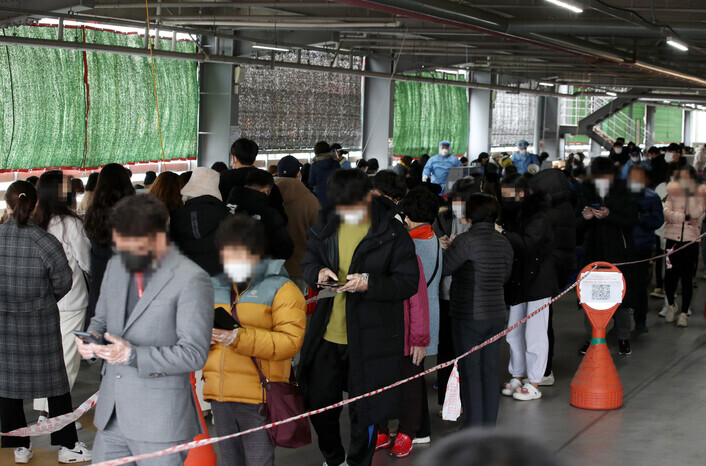hankyoreh
Links to other country sites 다른 나라 사이트 링크
S. Korea could see 30,000 COVID-19 cases per day by next month

As the Omicron variant continues to spread in Korea, the number of daily cases has exceeded 9,000 for the first time since the start of the pandemic. The surge in new cases is prompting concerns that daily case numbers could reach up to 200,000 by March.
Although health authorities are planning on shifting to the Omicron response system after the extended Lunar New Year holiday, some say the system should be implemented as soon as possible while also refining testing methods and at-home treatment options given the sharp increase in cases.
In an analysis released on Jan. 14, the Korea Disease Control and Prevention Agency and the Korea Institute of Science and Technology found that if social distancing measures are eased to allow for larger private gatherings (4 → 8 attendees) and later business hours (9 pm → 10 pm closing time), the number of new daily cases by the end of March could reach 30,000.
Health authorities also shared predictions Tuesday that Omicron cases will account for more than 90% of the total cases next month, with 20,000 to 30,000 new confirmed cases per day.
Experts, however, seem even more pessimistic.
Jung Jae-hun, a professor of preventive medicine at Gachon University, told the Hankyoreh over the phone that “assuming that the current disease control system is kept in place and that the transmissibility of Omicron is about twice that of the Delta variant, new daily cases could reach 50,000 next month.”
Jacob Lee, an infectious disease specialist at Hallym University Kangnam Sacred Heart Hospital, told CBS in an interview on Monday, “If the current medical and social distancing measures remain in place, the number of daily cases in March could reach up to 200,000.”
Starting Wednesday, four regions — Gwangju, South Jeolla Province, Pyeongtaek and Anseong — will shift their COVID-19 response strategy to providing polymerase chain reaction (PCR) tests for high-risk groups, self-test kits for the general population, and expansion of rapid antigen testing at clinics specializing in respiratory illnesses.
Son Young-rae, head of social strategy at Korea’s Central Disaster Management Headquarters, said that authorities are discussing switching to the Omicron response system “sometime after the Lunar New Year holiday.”
But experts suggest that the transition to this new response strategy needs to be made as soon as possible.
Jung Ki-suck, a professor at Hallym University Sacred Heart Hospital, told the Hankyoreh that “although there are fewer critically ill patients as of late, if the trend [of sharply rising daily cases] continues, the number of critical patients will also increase within a week to 10 days,” adding that Korea must “race to implement the Omicron response system.”
Moreover, experts also point to the urgency of preparing local medical institutions for managing at-home and outpatient treatment of the surging number of COVID-19 patients. As of Tuesday, there were 370 medical institutions managing at-home treatment and 51 outpatient care centers that patients receiving at-home care could visit.
Park Hyang, head of disease control policy coordination at the Central Safety and Disaster Countermeasure Headquarters, said at a press briefing Tuesday that health authorities “will expand the number of at-home treatment institutions to more than 400 in preparation for more than 20,000 confirmed cases per day.”
Meanwhile, Yoon Tae-ho, professor of preventive medicine at Pusan National University, said, “Consultations should also be made available at internal medicine clinics or family medicine facilities,” adding that localities should operate at least one clinic that can provide consultations after regular clinic hours.
Prepping additional respiratory clinics to handle testing and treatment of COVID-19 patients is a pressing task as well. A source working at one of these clinics in Seoul remarked that the process for handling COVID-19 patients “from taking specimens to [operating] negative pressure rooms” at a regular hospital is “no easy task.”
“It’s not enough just to keep [COVID and non-COVID patients] separate. Patients have to be classified, and the task of having to handle patients based on judgment poses its own challenges as well.”
By Park Jun-yong and Jang Hyeon-eun, staff reporters
Please direct questions or comments to [english@hani.co.kr]
Editorial・opinion
![[Column] Tariffs on China: Trump was dumb, Biden dumber [Column] Tariffs on China: Trump was dumb, Biden dumber](https://flexible.img.hani.co.kr/flexible/normal/500/300/imgdb/original/2024/0520/191716191153918.jpg) [Column] Tariffs on China: Trump was dumb, Biden dumber
[Column] Tariffs on China: Trump was dumb, Biden dumber![[Column] What if Seoul took reunification by force off the table? [Column] What if Seoul took reunification by force off the table?](https://flexible.img.hani.co.kr/flexible/normal/500/300/imgdb/original/2024/0520/3017161928630494.jpg) [Column] What if Seoul took reunification by force off the table?
[Column] What if Seoul took reunification by force off the table?- [Editorial] Intensifying US-China rivalry means Seoul must address uncertainty with Beijing sooner than later
- [Column] When ‘fairness’ means hate and violence
- [Editorial] Yoon must stop abusing authority to shield himself from investigation
- [Column] US troop withdrawal from Korea could be the Acheson Line all over
- [Column] How to win back readers who’ve turned to YouTube for news
- [Column] Welcome to the president’s pity party
- [Editorial] Korea must respond firmly to Japan’s attempt to usurp Line
- [Editorial] Transfers of prosecutors investigating Korea’s first lady send chilling message
Most viewed articles
- 1Xi, Putin ‘oppose acts of military intimidation’ against N. Korea by US in joint statement
- 2For new generation of Chinese artists, discontent is disobedience
- 3[Editorial] Transfers of prosecutors investigating Korea’s first lady send chilling message
- 4[Column] When ‘fairness’ means hate and violence
- 5[Editorial] Intensifying US-China rivalry means Seoul must address uncertainty with Beijing sooner t
- 6How K-pop broke the internet — and broke into the US market
- 7[Exclusive] Unearthed memo suggests Gwangju Uprising missing may have been cremated
- 8‘Shot, stabbed, piled on a truck’: Mystery of missing dead at Gwangju Prison
- 9Naver to acquire Canada’s Wattpad to fuel its IP ambitions
- 10AI, robots won’t free us from work - they’ll make our jobs worse